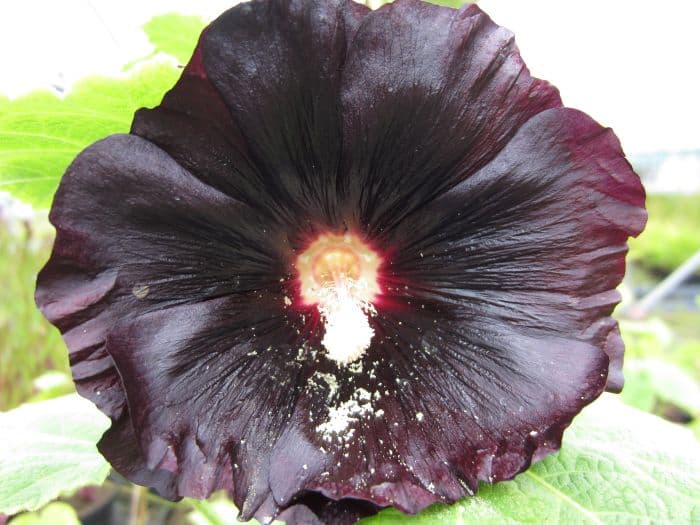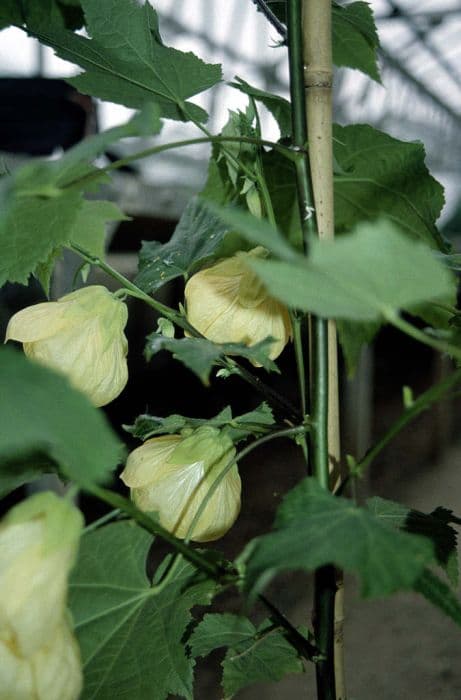Black Hollyhock Alcea rosea 'Nigra'

ABOUT
The plant named Alcea rosea 'Nigra', commonly known as the Black Hollyhock, is distinctive for its striking dark-colored blooms. These flowers are a deep, almost black shade of purple or maroon, making them stand out in the garden. Each petal has a satin-like texture and slightly ruffled edges, adding to the dramatic flair of the plant. The foliage of the Black Hollyhock forms a low-lying clump of heart-shaped leaves that are green, providing a lush backdrop for the tall spires of flowers that rise above them. The leaves may have a slightly hairy texture. Flowering stems are sturdy and hold the blooms aloft in a series of cup-shaped flowers that open in succession over a long period, from midsummer into fall. The blossoms' color and towering form make them a focal point in any garden setting. The Black Hollyhock is a biennial or short-lived perennial and is known for attracting pollinators like bees and butterflies, which are drawn to its vibrant color and rich nectar.
About this plant
 Names
NamesSynonyms
Black Hollyhock, Watchman, Nigra Hollyhock
Common names
Althaea rosea (L.) Cavanilles, Alcea rosea L.
 Toxicity
ToxicityTo humans
Hollyhocks are not considered toxic to humans. They are often grown for ornamental purposes and are not known to have poisonous parts. Therefore, ingesting parts of the hollyhock typically does not lead to poisoning or serious health consequences.
To pets
Hollyhocks are generally considered to be non-toxic to pets as well. They are not known to contain any substances that are harmful to dogs or cats if ingested. As a result, consumption of hollyhock parts is not expected to cause poisoning or adverse health effects in pets. However, as with any non-food plant, ingestion can sometimes lead to mild stomach upset due to the plant material.
 Characteristics
CharacteristicsLife cycle
Biennials
Foliage type
Deciduous
Color of leaves
Green
Flower color
Dark red
Height
6 feet [1.8 meters]
Spread
2 feet [0.6 meters]
Plant type
Herb
Hardiness zones
3
Native area
Asia
Benefits
 General Benefits
General Benefits- Attracts Pollinators: Alcea rosea 'Nigra', commonly known as Hollyhock, attracts bees, butterflies, and other pollinating insects, thereby supporting the local ecosystem.
- Ornamental Value: Hollyhocks provide visual interest with their tall spikes of dark, almost black, flowers, creating an elegant and dramatic display in gardens.
- Cottage Garden Aesthetic: Perfect for a cottage garden look, Hollyhocks add height and old-fashioned charm to any garden design.
- Vertical Interest: Hollyhocks grow vertically, reaching impressive heights, which can be used to draw the eye upwards in garden compositions.
- Easy to Grow: Hollyhocks are considered easy to grow from seed and require minimal maintenance, making them suitable for novice gardeners.
- Drought Tolerance: Once established, Hollyhocks can tolerate periods of drought, making them suitable for gardens in dryer climates.
- Historical Significance: With a long history of cultivation, Hollyhocks provide a sense of tradition and continuity in a garden setting.
- Cut Flowers: The blooms of Hollyhocks make for striking cut flowers, allowing gardeners to bring the beauty of their gardens indoors.
 Medical Properties
Medical Properties- Demulcent - Alcea rosea 'Nigra', commonly known as Hollyhock, has been used for its soothing properties, primarily for the respiratory and digestive systems.
- Emollient - The plant has been traditionally used externally for its softening and soothing effect on the skin.
- Diuretic - It is believed to promote the production of urine, helping in the elimination of fluids from the body.
- Anti-inflammatory - Hollyhock may possess anti-inflammatory properties that could help reduce inflammation.
 Air-purifying Qualities
Air-purifying QualitiesThis plant is not specifically known for air purifying qualities.
 Other Uses
Other Uses- Hollyhock dolls: The flowers of Alcea rosea 'Nigra' can be used to create whimsical dolls for children by using the blooms for skirts and buds for heads.
- Natural dye: The dark petals of the 'Nigra' variety can be used as a natural dye for fabrics, providing a range of purple and mauve hues.
- Papermaking: The fibrous stems of hollyhocks can be included in the papermaking process to add texture and interest to handmade paper.
- Companion planting: Hollyhocks attract beneficial insects to the garden including pollinators and natural pest predators.
- Culinary decoration: Although not commonly used for flavor, the dark blossoms can be used as an elegant garnish for desserts and salads.
- Photography: The striking black flowers of 'Nigra' provide a dramatic backdrop for garden photography and botanical illustration.
- Education: Hollyhocks can be used in educational settings to teach about plant biology, pollination, and historical uses of plants.
- Composting: After they have finished blooming, the leaves and stalks can be added to compost bins as a source of green matter.
- Livestock feed: In some parts of the world, the leaves of hollyhocks are used as fodder for livestock.
- Crafts: Dried hollyhock flowers can be used in crafting, such as in potpourri mixes or pressed flower arrangements.
Interesting Facts
 Feng Shui
Feng ShuiThe Hollyhock is not used in Feng Shui practice.
 Zodiac Sign Compitability
Zodiac Sign CompitabilityThe Hollyhock is not used in astrology practice.
 Plant Symbolism
Plant Symbolism- Fertility and Abundance: Alcea rosea 'Nigra', commonly known as Black Hollyhock, is often associated with fertility due to its prolific seed production and ability to self-sow, representing an abundant and fruitful life.
- Survival and Resilience: As a hardy plant that can grow in challenging conditions, the Black Hollyhock symbolizes the ability to withstand adversity and to keep thriving despite obstacles.
- Heartfelt Ambition: With its deep, almost black flowers reaching towards the sky, Black Hollyhock is frequently seen as a symbol of ambition and the desire to achieve one’s dreams.
- Beauty and Elegance: The unique, dark blossoms of the Black Hollyhock stand out in any garden, making it emblematic of singular beauty and the elegance of being different.
- Wealth and Success: The Black Hollyhock's luxurious color and lush growth are sometimes connected to prosperity and the attainment of success.
 Water
WaterHollyhocks should be watered deeply whenever the top inch of soil feels dry to the touch. For 'Nigra' Hollyhocks, this typically means providing about 1 to 1.5 gallons of water per plant every week during the growing season, depending on weather conditions and soil type. Ensure even moisture by using a watering can or hose to deliver water directly to the base of the plant, avoiding wetting the foliage to reduce the risk of disease. During the flowering period, they may require more frequent watering to support their large blooms, while in cooler or rainy periods, water less often.
 Light
Light'Nigra' Hollyhock thrives best in full sunlight, where it can receive at least 6 to 8 hours of direct sun daily. The ideal spot for them is in an open area, free from the shade of trees or buildings, which ensures robust growth and maximum flower production. They can tolerate some light shade but bloom best when they have plenty of sunshine.
 Temperature
Temperature'Nigra' Hollyhocks prefer a temperature range between 60 and 90 degrees Fahrenheit. They can tolerate a minimum temperature down to about 20 degrees Fahrenheit in winter, assuming they are properly mulched, but they grow best when temperatures remain within their preferred range. In extreme heat above 90 degrees Fahrenheit, 'Nigra' Hollyhocks may require additional watering to keep them healthy.
 Pruning
PruningPruning 'Nigra' Hollyhocks helps promote vigorous growth and prevent disease by improving air circulation. Trim away any dead or damaged foliage, and after blooming, cut the flower stalks down to the ground to encourage reblooming or to tidy the plant. The best time to prune is late winter to early spring before new growth begins, although spent flower stalks can be removed any time.
 Cleaning
CleaningAs needed
 Soil
SoilHollyhocks (Alcea rosea 'Nigra') thrive best in a well-draining soil mix enriched with organic matter, such as compost or aged manure. A soil pH of 6.0-7.0 is ideal for these plants. To create the best soil mix, combine two parts garden soil, one part peat moss, and one part compost or well-rotted manure. Additionally, ensure that the soil is loose and not compacted to promote good root development and water drainage.
 Repotting
RepottingHollyhocks (Alcea rosea 'Nigra') are biennials or short-lived perennials and do not generally require frequent repotting. They are typically sown directly outdoors where they are to flower and aren't repotted as they can develop very deep taproots. If you must move a hollyhock, it is best done when it is young before the taproot becomes too established.
 Humidity & Misting
Humidity & MistingHollyhocks (Alcea rosea 'Nigra') are tolerant of a wide range of humidity levels and do not require any special humidity considerations. They perform well in the varying humidity conditions typically found in outdoor environments, making them versatile and resilient.
 Suitable locations
Suitable locationsIndoor
Grow in bright light, keep moist, and ensure pot has drainage.
Outdoor
Plant in full sun, ensure rich soil, and well-drained location.
Hardiness zone
3-9 USDA
 Life cycle
Life cycleAlcea rosea 'Nigra', commonly known as the Black Hollyhock, begins its life as a seed, typically sown in late summer to early fall or in spring. Upon germination, it develops a rosette of leaves the first year, establishing a solid root system. In its second year, the Black Hollyhock sends up tall flower stalks that can reach 6 to 8 feet tall, featuring deep purple-black blossoms that bloom from mid-summer to early fall. After flowering, the plant produces capsules filled with seeds, completing the reproductive cycle. Once seed dispersal occurs, the plant may die back if it's treated as a biennial but can act as a short-lived perennial in some conditions, potentially resprouting the following spring. Over time, without human intervention, the Black Hollyhock will self-seed and continue to propagate in the garden.
 Propogation
PropogationPropogation time
Spring to Summer
Alcea rosea 'Nigra', commonly known as the Black Hollyhock, is typically propagated by seed. The best time to sow seeds is either in late summer or early fall, allowing them to establish roots before the cold sets in, or in early spring after the risk of frost has passed. Sowing seeds directly into the garden is the most popular method. To do this, one just scatters the seeds on prepared soil and lightly covers them with about a quarter inch (about 6 millimeters) of soil. Watering should be done gently to keep the seeds moist until germination, which usually takes anywhere from two to three weeks. Once seedlings have a couple of sets of true leaves and are strong enough, they should be thinned to eighteen inches (approximately 45 centimeters) apart to allow adequate space for growth.








![Rose of Sharon [Lavender Chiffon]](/_next/image?url=https%3A%2F%2Fplants-admin.emdemapps.com%2Fimages%2Fplants%2F%2Fimages%2F604b616c0ddec.png&w=640&q=75)
